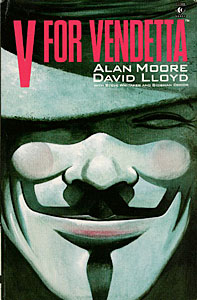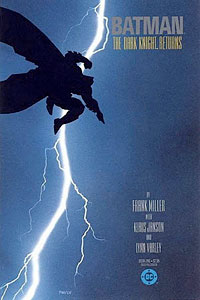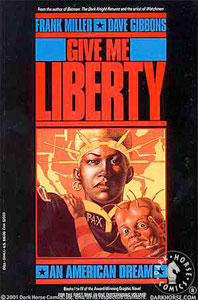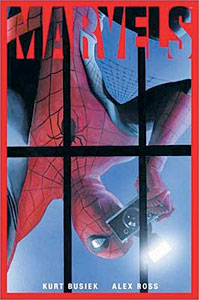Comics as Good as Watchmen
By Bert Ehrmann
March 20, 2009
The Watchmen movie opened in theaters a few weeks back generating nearly $60 million in ticket sales capturing the number one spot opening weekend. Even though the movie was a little over two hours in length, there was no way that it could have ever come close to the depth of the original 380 page Watchmen series of comics originally published back in 1986.
 To literally translate the comics to film form would have meant a movie that was at least nine or ten hours long costing untold sums of cash. That being said, a kind of story, which isn’t very practical in movie form, is PERFECT for the comic book medium.
To literally translate the comics to film form would have meant a movie that was at least nine or ten hours long costing untold sums of cash. That being said, a kind of story, which isn’t very practical in movie form, is PERFECT for the comic book medium.
I talked a lot about the Watchmen comic last time, so I won’t go into much detail it here. If you’re unfamiliar with comic books in general then Watchmen is a great place to start.
After you’ve read Watchmen, written by Alan Moore and illustrated by Dave Gibbons, read the series V for Vendetta (1982) by Moore and David Lloyd. If you’ve seen the movie version of Vendetta then you’ve really only seen a light pastiche of the Vendetta story. The comic version of Vendetta is dark and uncompromising, everything the movie wasn’t.
 If you’ve read both Watchmen and Vendetta and are hungry for more, checkout an Alan Moore “deeper cut” with his Miracleman/Marvelman (1982) storyline. Because of a rights dispute, this series has been held in limbo these last few years so finding back issues can be difficult at best. But trust me, it’s worth it.
If you’ve read both Watchmen and Vendetta and are hungry for more, checkout an Alan Moore “deeper cut” with his Miracleman/Marvelman (1982) storyline. Because of a rights dispute, this series has been held in limbo these last few years so finding back issues can be difficult at best. But trust me, it’s worth it.
Just before Watchmen was first published Batman: The Dark Knight Returns (1986) written and illustrated by Frank Miller was released. Before Dark Knight the Batman character was mostly a campy holdover from the 1960s live-action TV series and the 1970s and 80s Superfriends Saturday morning cartoons. After Dark Knight, Batman was stripped back down to his essence of a moody avenger that roamed the streets of a dark and dirty Gotham looking to pulverize criminals. Essentially everything that makes the modern version of Batman, well, Batman can be traced back to Dark Knight. Let’s put it this way, without Miller and Dark Knight there could have been no The Dark Knight (2008) movie or Oscar for Heath Ledger.
 After you’ve read Dark Knight, checkout Miller’s Give Me Liberty (1990) about a girl named Martha Washington. Washington is born in 1990 and grows up to become a soldier in a shattered country where the U.S. is fighting a war in the jungles of South America against a fast food conglomerate, the Surgeon General is a robot and all that’s left of the President after an assassination attempt is his brain in a bottle that still gives orders. Good fun for all!
After you’ve read Dark Knight, checkout Miller’s Give Me Liberty (1990) about a girl named Martha Washington. Washington is born in 1990 and grows up to become a soldier in a shattered country where the U.S. is fighting a war in the jungles of South America against a fast food conglomerate, the Surgeon General is a robot and all that’s left of the President after an assassination attempt is his brain in a bottle that still gives orders. Good fun for all!
Miller also wrote the Sin City comic, co-directed the film, created the original comic for 300 and wrote and directed The Sprit.
One modern comic classic is Alex Ross and Mark Waid’s ode to the end of the DC Comics universe with Kingdom Come (1996). In this story, it’s a decade or two in the future and a civil war is brewing between two camps of superheroes – one led by Superman and the other Batman. Things have gotten so out of control with the “modern” superheroes that Superman has decided to rein them in and finds that Batman won’t go along with his plans. And then they both find that things aren’t what they seem when it turns out that a mysterious villain from their past might just be behind everything. Rest assured that the story ends with one heck'uva bang.
 When you finish with Kingdom Come read Ross’s and Kurt Busiek’s Marvels (1994). Whereas Kingdom Come tells the story of the destruction of the DC Comics Universe, Marvels tells the story of the creation of the Marvel Comics universe from the 1930s up until sometime in the 1970s. For a guy who started reading comics in the 1980s seeing just where all the characters I loved started out at was one interesting trip.
When you finish with Kingdom Come read Ross’s and Kurt Busiek’s Marvels (1994). Whereas Kingdom Come tells the story of the destruction of the DC Comics Universe, Marvels tells the story of the creation of the Marvel Comics universe from the 1930s up until sometime in the 1970s. For a guy who started reading comics in the 1980s seeing just where all the characters I loved started out at was one interesting trip.
Most of the comics/graphic novels listed above can be picked up at your local book or comic book retailer.